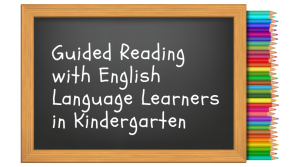 Do you work with English Language Learners or have English Language Learners in your classroom? Whether your classroom has only a few ELLs or a majority, it’s critical to think about different strategies and skills that ELLs need to engage with books as they’re starting to read in kindergarten.
Do you work with English Language Learners or have English Language Learners in your classroom? Whether your classroom has only a few ELLs or a majority, it’s critical to think about different strategies and skills that ELLs need to engage with books as they’re starting to read in kindergarten.
It’s also essential that your classroom library has authentic and culturally relevant texts in both English and Spanish so that all readers can have texts that fit their needs and interests. To get started, we recommend evaluating your classroom library. Our Classroom Library Questionnaire is a tool that can help you analyze the books in your library and determine where there are strengths and gaps in diversity.
Read on to find out different skills that you can teach ELLs when they’re reading at levels A, B, and C.
One-to-one matching
- One-to-one matching requires more than just vocabulary: it also requires knowledge of how language is supposed to sound. Use books that are written in the present tense, and later move to different tenses. Children tend to understand statements and commands before questions, so it helps to read books with these kinds of sentences until children acquire other language structures.
Using pictures and the text to read
- Prompting a child to check the picture will only work if the child knows the word for what is pictured. When a child does not know the word, it can be taught during the conference. Be sure to provide a context. If possible, teach the child what the word is like, what it is not like, and what it does.
- If the teacher knows that there will be unfamiliar vocabulary in the book, preteach a few words before children attempt to read the book.
- Provide a separate word wall handout for ELLs that is tailored to their needs. Keep this in a folder or on a stand as a reference for children as they read.
Retelling/summarizing/synthesizing
- When coaching, use gestures and fingers to indicate sequential retelling. For example, hold up one finger for “first,” two fingers for “next,” and so on. This reinforces sequential retelling and provides nonverbal cues for children to follow.
- If a child is more skilled at understanding English than speaking English, have him or her draw pictures to explain what happened in the story.
Inferring
- ELLs may need more visual cues to comprehend directions and make inferences. Try drawing speech balloons on stick notes and placing them above characters’ heads. Point to the speech balloon(s) on each page. Ask children to think about what the characters might be saying.
- Use Cleaning Day and have students come up with what the daughter could be saying to her father based on her facial expressions and actions. For example, when they see the mess on p. 2, have students write in speech bubbles above the daughter and father’s heads about what they could be saying.
Interested in ordering dual language Guided Reading English and Spanish books for your kindergarten classroom? Check out our collections of dual language books at levels A, B, and C below:
- Bebop English Guided Reading Level A
- Bebop Spanish Guided Reading Level A
- Bebop English Guided Reading Level B
- Bebop Spanish Guided Reading Level B
- Bebop English Guided Reading Level C
- Bebop Spanish Guided Reading Level C
These tips and more can be found in our Reading Conferences by Bebop Books Guide. We are proud to feature these new Conferencing Documents as essential resources for teachers in the classroom working with beginning readers.
Our Conferencing Guide include tips and techniques for conferring with readers at levels A, B, and C. The Guide also includes “Teaching Cheat Sheets” that feature how to examine a student’s reading behavior, and turn those observations into teaching moments so students can achieve the targeted reading skill.
Missed our posts in our Guided Reading in Kindergarten series? Click below to read more:









